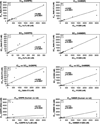Pharmacology and selectivity of various natural and synthetic bombesin related peptide agonists for human and rat bombesin receptors differs
- PMID: 21729729
- PMCID: PMC3152620
- DOI: 10.1016/j.peptides.2011.06.017
Pharmacology and selectivity of various natural and synthetic bombesin related peptide agonists for human and rat bombesin receptors differs
Abstract
The mammalian bombesin (Bn)-receptor family [gastrin-releasing peptide-receptor (GRPR-receptor), neuromedin B-receptor (NMB receptor)], their natural ligands, GRP/NMB, as well as the related orphan receptor, BRS-3, are widely distributed, and frequently overexpressed by tumors. There is increased interest in agonists for this receptor family to explore their roles in physiological/pathophysiological processes, and for receptor-imaging/cytotoxicity in tumors. However, there is minimal data on human pharmacology of Bn receptor agonists and most results are based on nonhuman receptor studies, particular rodent-receptors, which with other receptors frequently differ from human-receptors. To address this issue we compared hNMB-/GRP-receptor affinities and potencies/efficacies of cell activation (assessing phospholipase C activity) for 24 putative Bn-agonists (12 natural, 12 synthetic) in four different cells with these receptors, containing native receptors or receptors expressed at physiological densities, and compared the results to native rat GRP-receptor containing cells (AR42J-cells) or rat NMB receptor cells (C6-glioblastoma cells). There were close correlations (r=0.92-99, p<0.0001) between their affinities/potencies for the two hGRP- or hNMB-receptor cells. Twelve analogs had high affinities (≤ 1 nM) for hGRP receptor with 15 selective for it (greatest=GRP, NMC), eight had high affinity/potencies for hNMB receptors and four were selective for it. Only synthetic Bn analogs containing β-alanine(11) had high affinity for hBRS-3, but also had high affinities/potencies for all GRP-/hNMB-receptor cells. There was no correlation between affinities for human GRP receptors and rat GRP receptors (r=0.131, p=0.54), but hNMB receptor results correlated with rat NMB receptor (r=0.71, p<0.0001). These results elucidate the human and rat GRP-receptor pharmacophore for agonists differs markedly, whereas they do not for NMB receptors, therefore potential GRP-receptor agonists for human studies (such as Bn receptor-imaging/cytotoxicity) must be assessed on human Bn receptors. The current study provides affinities/potencies on a large number of potential agonists that might be useful for human studies.
Published by Elsevier Inc.
Figures





References
-
- Barra D, Erspamer Falconieri G, Simmaco M, Bossa F, Melchiorri P, Erspamer V. Rohdeilitorin: a new peptide from the skin of Phyllomedusa rohdei. FEBS Lett. 1985;182:53–56. - PubMed
-
- Benya RV, Fathi Z, Pradhan T, Battey JF, Kusui T, Jensen RT. Gastrin-releasing peptide receptor-induced internalization, down-regulation, desensitization and growth: Possible role of cAMP. Mol Pharmacol. 1994;46(2):235–245. - PubMed
-
- Benya RV, Kusui T, Pradhan TK, Battey JF, Jensen RT. Expression and characterization of cloned human bombesin receptors. Mol Pharmacol. 1995;47:10–20. - PubMed
-
- Benya RV, Wada E, Battey JF, Fathi Z, Wang LH, Mantey SA, et al. Neuromedin B receptors retain functional expression when transfected into BALB 3T3 fibroblasts: analysis of binding, kinetics, stoichiometry, modulation by guanine nucleotide-binding proteins, and signal transduction and comparison with natively expressed receptors. Mol Pharmacol. 1992;42(6):1058–1068. - PubMed
-
- Breeman WA, Kwekkeboom DJ, de Blois E, de Jong M, Visser TJ, Krenning EP. Radiolabelled regulatory peptides for imaging and therapy. Anticancer Agents Med Chem. 2007;7:345–357. - PubMed
Publication types
MeSH terms
Substances
Grants and funding
LinkOut - more resources
Full Text Sources
Molecular Biology Databases

